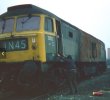musicindetail
Member
I recently spoke to someone who witnessed the immediate aftermath of this incident. As well as his recollections, I've seen several photographs of the loco following the incident, one taken in the loco holding sidings at Ipswich, and several taken at Crewe Works. Having very little technical knowledge myself, can anyone tell me what would cause so much physical damage to 1562? I realise that any explosion would cause damage, but the extent of the fire damage to this loco was extreme enough to see it scrapped while severely damaged 47163 was repaired and put back into service following its collision and resulting fire at Kensal Green in (I think) 1977.



